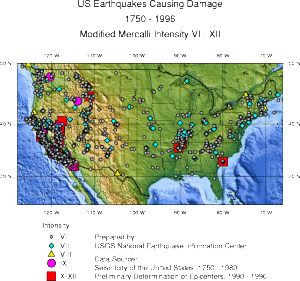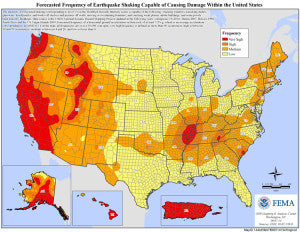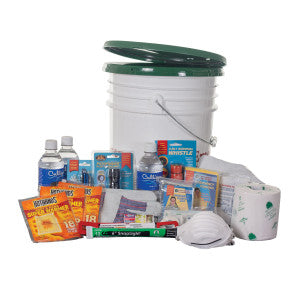Maralin Hoff, the “Earthquake Lady,” from the Division of Emergency Management in the Utah Department of Public Safety, has traveled all over Utah teaching state residents how to prepare for earthquakes. In her travels over the last 20 years, she’s heard a lot of earthquake myths. Here are a few she’s heard and a few more collected from around the web.
Earthquake Myth #1: You don’t have to think about earthquakes in most states

While California and Alaska are generally considered the most seismically active areas in North America, Oklahoma had that distinction in 2014. The state saw a huge increase in the number of earthquakes of magnitude 3 or greater, according to the U.S. Geological Survey.
For that matter, in the last 250 years nearly every state has seen an earthquake of intensity of level VI (6) or higher on the Modified Mercalli Scale, according to this USGS map. The
Modified Mercalli Scale measures earthquake damage. Level VI denotes a severe earthquake that can include damage like broken windows, heavy furniture moved, plaster cracks and falling objects.
Earthquake Myth #2: Earthquakes are predictable
“Imagine looking at a freshly plastered wall and trying to predict where the first crack will show up. That’s where we’re at with earthquake prediction right now,” said California Geological Service Supervising Geologist Charles Real, in a release.

Earthquake scientists can, however, suggest earthquake probabilities.
This map from the USGS shows a forecast for how often areas in the U.S. might see a level VI or higher earthquake.
“We don’t claim any special insight into when earthquakes will occur – simply the knowledge that they’ve occurred in the past and will occur in the future.” said Dr. John Parrish, the California State Geologist, in a release.
Earthquake Myth #3: Don’t “Drop, Cover and Hold On.”
Stephanie Robertson, who was raised in California and lived through several earthquakes, remembers being taught to stand in a door frame during an earthquake. Nowadays, that’s
not recommended.
Hoff said many door frames today are made of metal inside, though they may look like wood. Therefore a door frame without windows or glass nearby might provide some protection in a building collapse. However, as the Earthquake Country Alliance pointed out, the frame won’t protect you from flying objects – or, for that matter, the swinging door.
Hoff says the best way to protect yourself in an earthquake is
Drop, Cover and Hold On. It’s pretty self-explanatory. If you feel an earthquake, do the following:
- Drop to your hands and knees.
- Cover your head and neck with both arms. If there’s a sturdy desk or table nearby, crawl under it, keeping one arm over your head. If there isn’t, go next to an interior wall or low-lying furniture that won’t fall on you.
- Hold on to your shelter (or head and neck) until the shaking stops.

A few years ago, some web postings suggested protecting yourself in a “triangle of life,” where you crouch down beside a shelter such as a table, instead of under it. Hoff said she researched the idea when she first saw it then consulted with many other experts.
They disagreed with it.
“To make a long story short,” she said, “We’re still teaching students [Drop-Cover-Hold On].”
Hoff pointed out you can’t direct which way objects will fall during an earthquake.
“Who’s to guarantee a tall piece of furniture is going to hit the table and not you if you’re beside (and not under) it?” she asked.
Earthquake Myth #4: It costs a lot of money to prepare an emergency kit
[caption id="attachment_19283" align="alignright" width="300"]

Earthquake Emergency Kit - Earthquake Myth[/caption]
Yes, some emergency kits can cost hundreds of dollars. And, frankly, it is way more convenient to buy a kit that’s all packed up and ready to go, with almost everything you need. Heck, for this ShakeOut season (happening October 15 in your state), we’ve put our
Earthquake Emergency Kit on sale, so you don’t have to sell your firstborn to be prepared.
However, you don’t have to go that route, Hoff said. Ready.gov and others have lists of what to put in
emergency kits, and
Hoff’s own list is here. Be Ready Utah has a “
Top 10 List for Preparedness on a Budget.”
“We think an emergency kit is going to cost an arm and a leg. No. It’s a shoestring,” Hoff said.
Earthquake Myth #5: Everyone will panic when “the big one” hits
“Research shows that people usually take protective actions and help others both during and after the shaking. Most people don't get too shaken up about being shaken up,” according to the Earthquake Country Alliance.
Hoff’s mantra is “Train Your Brain.”
In other words, by thinking about what you would do in an earthquake, and preparing for it, you’ll be able to act without panicking if one occurs. And then you’ll be able to help others.
- Melissa
What are some other earthquake myths that you have heard? Let us know in the comments!

 While California and Alaska are generally considered the most seismically active areas in North America, Oklahoma had that distinction in 2014. The state saw a huge increase in the number of earthquakes of magnitude 3 or greater, according to the U.S. Geological Survey.
For that matter, in the last 250 years nearly every state has seen an earthquake of intensity of level VI (6) or higher on the Modified Mercalli Scale, according to this USGS map. The Modified Mercalli Scale measures earthquake damage. Level VI denotes a severe earthquake that can include damage like broken windows, heavy furniture moved, plaster cracks and falling objects.
Earthquake Myth #2: Earthquakes are predictable
“Imagine looking at a freshly plastered wall and trying to predict where the first crack will show up. That’s where we’re at with earthquake prediction right now,” said California Geological Service Supervising Geologist Charles Real, in a release.
While California and Alaska are generally considered the most seismically active areas in North America, Oklahoma had that distinction in 2014. The state saw a huge increase in the number of earthquakes of magnitude 3 or greater, according to the U.S. Geological Survey.
For that matter, in the last 250 years nearly every state has seen an earthquake of intensity of level VI (6) or higher on the Modified Mercalli Scale, according to this USGS map. The Modified Mercalli Scale measures earthquake damage. Level VI denotes a severe earthquake that can include damage like broken windows, heavy furniture moved, plaster cracks and falling objects.
Earthquake Myth #2: Earthquakes are predictable
“Imagine looking at a freshly plastered wall and trying to predict where the first crack will show up. That’s where we’re at with earthquake prediction right now,” said California Geological Service Supervising Geologist Charles Real, in a release.
 Earthquake scientists can, however, suggest earthquake probabilities. This map from the USGS shows a forecast for how often areas in the U.S. might see a level VI or higher earthquake.
“We don’t claim any special insight into when earthquakes will occur – simply the knowledge that they’ve occurred in the past and will occur in the future.” said Dr. John Parrish, the California State Geologist, in a release.
Earthquake Myth #3: Don’t “Drop, Cover and Hold On.”
Stephanie Robertson, who was raised in California and lived through several earthquakes, remembers being taught to stand in a door frame during an earthquake. Nowadays, that’s not recommended.
Hoff said many door frames today are made of metal inside, though they may look like wood. Therefore a door frame without windows or glass nearby might provide some protection in a building collapse. However, as the Earthquake Country Alliance pointed out, the frame won’t protect you from flying objects – or, for that matter, the swinging door.
Hoff says the best way to protect yourself in an earthquake is Drop, Cover and Hold On. It’s pretty self-explanatory. If you feel an earthquake, do the following:
Earthquake scientists can, however, suggest earthquake probabilities. This map from the USGS shows a forecast for how often areas in the U.S. might see a level VI or higher earthquake.
“We don’t claim any special insight into when earthquakes will occur – simply the knowledge that they’ve occurred in the past and will occur in the future.” said Dr. John Parrish, the California State Geologist, in a release.
Earthquake Myth #3: Don’t “Drop, Cover and Hold On.”
Stephanie Robertson, who was raised in California and lived through several earthquakes, remembers being taught to stand in a door frame during an earthquake. Nowadays, that’s not recommended.
Hoff said many door frames today are made of metal inside, though they may look like wood. Therefore a door frame without windows or glass nearby might provide some protection in a building collapse. However, as the Earthquake Country Alliance pointed out, the frame won’t protect you from flying objects – or, for that matter, the swinging door.
Hoff says the best way to protect yourself in an earthquake is Drop, Cover and Hold On. It’s pretty self-explanatory. If you feel an earthquake, do the following:
 A few years ago, some web postings suggested protecting yourself in a “triangle of life,” where you crouch down beside a shelter such as a table, instead of under it. Hoff said she researched the idea when she first saw it then consulted with many other experts. They disagreed with it.
“To make a long story short,” she said, “We’re still teaching students [Drop-Cover-Hold On].”
Hoff pointed out you can’t direct which way objects will fall during an earthquake.
“Who’s to guarantee a tall piece of furniture is going to hit the table and not you if you’re beside (and not under) it?” she asked.
Earthquake Myth #4: It costs a lot of money to prepare an emergency kit
[caption id="attachment_19283" align="alignright" width="300"]
A few years ago, some web postings suggested protecting yourself in a “triangle of life,” where you crouch down beside a shelter such as a table, instead of under it. Hoff said she researched the idea when she first saw it then consulted with many other experts. They disagreed with it.
“To make a long story short,” she said, “We’re still teaching students [Drop-Cover-Hold On].”
Hoff pointed out you can’t direct which way objects will fall during an earthquake.
“Who’s to guarantee a tall piece of furniture is going to hit the table and not you if you’re beside (and not under) it?” she asked.
Earthquake Myth #4: It costs a lot of money to prepare an emergency kit
[caption id="attachment_19283" align="alignright" width="300"] Earthquake Emergency Kit - Earthquake Myth[/caption]
Yes, some emergency kits can cost hundreds of dollars. And, frankly, it is way more convenient to buy a kit that’s all packed up and ready to go, with almost everything you need. Heck, for this ShakeOut season (happening October 15 in your state), we’ve put our Earthquake Emergency Kit on sale, so you don’t have to sell your firstborn to be prepared.
However, you don’t have to go that route, Hoff said. Ready.gov and others have lists of what to put in emergency kits, and Hoff’s own list is here. Be Ready Utah has a “Top 10 List for Preparedness on a Budget.”
“We think an emergency kit is going to cost an arm and a leg. No. It’s a shoestring,” Hoff said.
Earthquake Myth #5: Everyone will panic when “the big one” hits
“Research shows that people usually take protective actions and help others both during and after the shaking. Most people don't get too shaken up about being shaken up,” according to the Earthquake Country Alliance.
Hoff’s mantra is “Train Your Brain.”
In other words, by thinking about what you would do in an earthquake, and preparing for it, you’ll be able to act without panicking if one occurs. And then you’ll be able to help others.
- Melissa
What are some other earthquake myths that you have heard? Let us know in the comments!
Earthquake Emergency Kit - Earthquake Myth[/caption]
Yes, some emergency kits can cost hundreds of dollars. And, frankly, it is way more convenient to buy a kit that’s all packed up and ready to go, with almost everything you need. Heck, for this ShakeOut season (happening October 15 in your state), we’ve put our Earthquake Emergency Kit on sale, so you don’t have to sell your firstborn to be prepared.
However, you don’t have to go that route, Hoff said. Ready.gov and others have lists of what to put in emergency kits, and Hoff’s own list is here. Be Ready Utah has a “Top 10 List for Preparedness on a Budget.”
“We think an emergency kit is going to cost an arm and a leg. No. It’s a shoestring,” Hoff said.
Earthquake Myth #5: Everyone will panic when “the big one” hits
“Research shows that people usually take protective actions and help others both during and after the shaking. Most people don't get too shaken up about being shaken up,” according to the Earthquake Country Alliance.
Hoff’s mantra is “Train Your Brain.”
In other words, by thinking about what you would do in an earthquake, and preparing for it, you’ll be able to act without panicking if one occurs. And then you’ll be able to help others.
- Melissa
What are some other earthquake myths that you have heard? Let us know in the comments!


